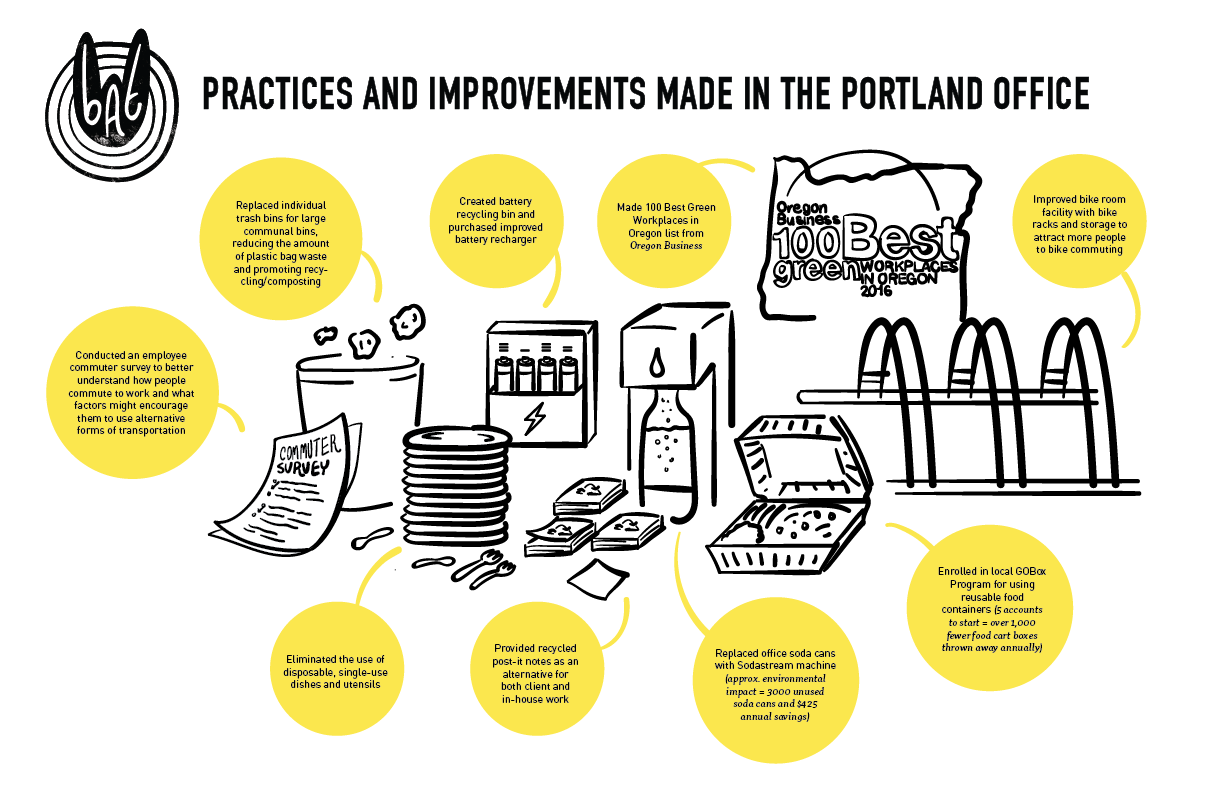This fall we officially launched BAT, XPLANE’s Betterment Action Team. BAT’s cross-functional team was formed to enact more environmentally conscious practices in-house and explore new opportunities for community outreach and involvement. Launching BAT didn’t happen overnight though.
Just over a year ago I began work at XPLANE, coming most recently from an energy and sustainability management firm called Ecova where eco-consciousness was second nature. My senses were finely attuned to behaviors and business areas at XPLANE that could use improvement. The more I saw, the more I believed that I could utilize my specific perspective to suggest alternatives and improvements at XPLANE. I didn’t want to come off holier-than-thou in suggesting we make changes and I didn’t want any efforts we made as a team to come off as green washing or being more progressive than we are. So, I created a four-step plan for launching a sustainability initiative at XPLANE that would be relevant to our day-to-day practices in the office and our brand.
Step One: Do a Sustainability Audit of Office
Since most of my initial observations were surface level, I wanted to check my assumptions about practices and behaviors in a systematic way. I enlisted the help of former coworker and sustainability expert Kylene Young to guide me through the process. We used Carnegie Mellon’s Environmentally Sustainable Checklist and conducted a walkthrough of the office to look at supplies we use, where recycle and waste bins were located, what type of energy-saving lighting and power systems were in place, and what type of employee behaviors had been instilled.
Since our office building was LEED-certified with a lot of efficiencies built in, we knew we were already doing some things well, but we had lots of room for improvement. This audit gave me a baseline from which to start.
Step Two: Show the Business Case
I knew I needed to galvanize leadership’s backing and my colleagues’ interest, proving that this initiative was not a personal crusade, but a smart business move. Taking action was imperative for credibility with our clients as well as in the eco-savvy Portland community where this kind of initiative is the standard. Not only did this effort make us look credible to the community, but it supported our recruiting efforts as a whole, landing us a spot in the 100 Best Green Workplaces in Oregon list from Oregon Business. Plus, these improvements could actually save us money, and sustainability initiatives could empower and engage employees to take change into their own hands.
Step Three: Build a Cross-Functional Team
This project was something that couldn’t be done alone. I needed a dedicated, cross-functional team that could define sustainability goals, lead initiatives, and promote new behaviors. Our team members come from different functions and levels within the company, bringing broad expertise and opportunities for influence. To make the most impact, we agreed on four main areas on which to focus our efforts: waste, transportation, behaviors, and community. We also identified a mission for our team: Working toward a better self, better company, and better world through reducing our environmental impact and contributing to our community.
Step Four: Take Action!
Since November, the BAT team has been able to plan out areas of focus for 2016 with quarterly and annual goals and benchmarks. We’ve already implemented new practices and improvements in the Portland office:
- Replaced individual trash bins for large communal bins, reducing the amount of plastic bag waste and promoting recycling/composting
- Eliminated the use of disposable, single-use dishes and utensils
- Enrolled in local GOBox Program for using reusable food containers (5 accounts to start = over 1,000 fewer food cart boxes thrown away annually)
- Created battery recycling bin and purchased improved battery charger
- Replaced office soda cans with Sodastream machine
(approx. environmental impact = 3000 unused soda cans and $425 annual savings) - Provided recycled post-it notes as an alternative for both client and in-house work
- Conducted an employee commuter survey to better understand how people commute to work and what factors might encourage them to use alternative forms of transportation
- Improved bike room facility with bike racks and storage to attract more people to bike commuting
A lot of the things we’re doing are still new, so we have yet to collect clear metrics to see how well we’re doing and how much impact the new improvements have had. The biggest tangible change I see is that there’s a day-to-day conversation about change and eco-conscious behaviors. People are excited about what we’re doing and critical of what we have not done yet, so we’re always getting feedback and ideas for improvement. I’m excited to see how far we’ve come in just a year and eager to see where we measure up a year from now.
Helpful Resources:
G4 Sustainability Reporting Guidelines
Carnegie Mellon Environmental Sustainability Checklist
LEED Certification
City of Portland Sustainability Certification
B Corp Certification
AIGA Living Principles of Design

